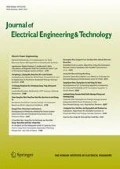Abstract
Electric railways are subjected to preventive maintenance to maintain a stable supply of electric energy to railway vehicles. The feeder cable is the main equipment of an electric railway that supplies stable electric energy to the Overhead Contact Line. The airport railway in Korea has many bridge sections and a feeder cable is used to secure the insulation distance from the messenger wire. A bridge section is a complex structure consisting of two stories, and the railway section on the lower story consists of a structure similar to the tunnel on the upper story. However, the insulation equipment on the lower story is decontaminate from natural environment such as rain, snow, tunnel and see. The lower story is closer to exposed locations such as the sea, and the degradation rate is high due to salt damage. In this paper, we propose a method for increasing the life expectancy of insulation equipment installed in a section subject to salt damage. Therefore, the insulation performance of the feeder cable installed on a sea bridge was measured. The life-cycle assessment was shown in a health index by applying a weighted average. In addition, the life expectancy was predicted by considering the health index and the remaining life.


Similar content being viewed by others
References
Kobayasi T, Fujihasi Y, Tsuburaya T, Satoh J, Oura Y, Fujii Y (1998) Current collecting performance of overhead contact line-pantograph system at 425 km/h. Electr Eng Jpn 124(3):73–81
Mandai T, Shimizu M, Harada S (2003) Development of rigid conductor line for high-speed operation. In: IEEE international conference on industrial technology, 2003, vol 1. IEEE, pp 587–592
Sezgin ME, Göl M (2017) Voltage variation model for DC catenary line of a subway system. In: 2017 IEEE Manchester PowerTech. IEEE, pp 1–6
Garcia P, Fernandez LM, Garcia CA, Jurado F (2009) Energy management system of fuel-cell-battery hybrid tramway. IEEE Trans Ind Electron 57(12):4013–4023
Wu T, Brennan M (1999) Dynamic stiffness of a railway overhead wire system and its effect on pantograph–catenary system dynamics. J Sound Vib 219(3):483–502
Chiriac G, Nituca C, Cardasim M (2017) Failures analysis in the 25 kV/50 Hz railway substations. In: 2017 international conference on electromechanical and power systems (SIELMEN). IEEE, pp 407–410
Bruni S, Bucca G, Carnevale M, Collina A, Facchinetti A (2018) Pantograph–catenary interaction: recent achievements and future research challenges. Int J Rail Transp 6(2):57–82
Zhong-guo S, Jing W (2016) An overview research of pre-warning inspection on pollution-flashover of insulator on overhead contact line in electrified railway. DEStech Trans Eng Technol Res 268–274
Suh YH, Kim KS, Han SW, Yoon SH (2012) A research on analyzing current status and ways to improve access transportation to Incheon International Airport. J Korean Soc Aviat Aeronaut 20(4):106–114
Jung H, Park Y (2019) A case study of degradation characteristics for rod-insulator on catenary system in electric railway. J Korean Inst Electr Electron Mater Eng 32(4):263–266
Na K-M, Jung H-S, Shin S-K, Kim H (2020) Performance evaluation analysis program for electric railway facilities. J Korean Soc Railw 23(6):542–550
Hjartarson T, Otal S (2006) Predicting future asset condition based on current health index and maintenance level. In: ESMO 2006–2006 IEEE 11th international conference on transmission & distribution construction, operation and live-line maintenance. IEEE
Naderian A, Cress S, Piercy R, Wang F, Service J (2008) An approach to determine the health index of power transformers. In: Conference record of the 2008 IEEE international symposium on electrical insulation. IEEE, pp 192–196
Hodkiewicz MR (2015) The development of ISO 55000 series standards. In: Engineering asset management-systems, Professional Practices and Certification. Springer, Belgrade, pp 427–438
Acknowledgements
This research was supported by a grant from R&D Program of the Korea Railroad Research Institute, Republic of Korea
Author information
Authors and Affiliations
Corresponding author
Additional information
Publisher's Note
Springer Nature remains neutral with regard to jurisdictional claims in published maps and institutional affiliations.
Rights and permissions
About this article
Cite this article
Na, KM., Jung, H. & Park, Y. Life-Cycle Assessment of a Railway Electric Power Feeding Cable for Replacement Planning: A Case Study of an Electric Railway in Korea. J. Electr. Eng. Technol. 16, 2275–2280 (2021). https://doi.org/10.1007/s42835-021-00726-4
Received:
Revised:
Accepted:
Published:
Issue Date:
DOI: https://doi.org/10.1007/s42835-021-00726-4




